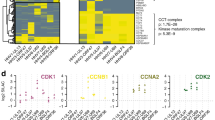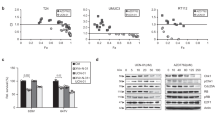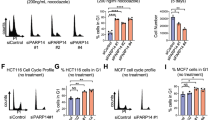Abstract
Viral DNA replication is generally dependent upon circumventing host cell cycle control to force S phase entry in an otherwise quiescent cell. Here we describe novel attributes of the cyclin encoded by Human Herpesvirus 8 (K cyclin) that enable it to subvert the quiescent state. K cyclin is most similar to the mammalian D-type cyclins in primary sequence but displays properties more akin to those of cyclin E. K cyclin (like cyclin E) can autonomously couple with its cognate cdk subunit and localize to the nucleus. D-type cyclins require mitogen stimulated accessory factors (such as p21Cip1 and p27Kip1) to facilitate both of these processes. A striking difference between K cyclin and mammalian cyclins is that K cyclin binding to cdk6 can substantially activate the catalytic activity of the complex without the requirement for cyclin H/cdk7 phosphorylation of the cdk T-loop; this phosphorylation is obligatory for endogenous cyclin/cdk activity. However, K cyclin/cdk6 complexes are not totally immune from cell cycle control since CAK phosphorylation is necessary for complete activation. Thus, CAK phosphorylated K cyclin/cdk6 targets multiple sites in the retinoblastoma protein (pRb) whereas the unphosphorylated complex targets a single site. The restricted substrate specificity of the non-CAK phosphorylated K cyclin/cdk6 complex is insufficient to enable K cyclin-mediated S phase entry. Thus, the viral K cyclin is reliant upon endogenous CAK activity to subvert the quiescent state.
This is a preview of subscription content, access via your institution
Access options
Subscribe to this journal
Receive 50 print issues and online access
$259.00 per year
only $5.18 per issue
Buy this article
- Purchase on Springer Link
- Instant access to full article PDF
Prices may be subject to local taxes which are calculated during checkout








Similar content being viewed by others
References
Arooz T, Yam CH, Siu WY, Lau A, Li KK, Poon RY . 2000 Biochemistry 39: 9494–9501
Bates S, Bonetta L, MacAllan D, Parry D, Holder A, Dickson C, Peters G . 1994 Oncogene 91: 71–79
Bridger JM, Kill IK, O Farrell M, Hutchinson CJ . 1993 J. Cell Sci. 104: 297–306
Brown AJ, Jones T, Shuttleworth J . 1994 Mol. Biol. Cell 5: 921–932
Brown NR, Noble ME, Endicott JA, Johnson LN . 1999 Nature Cell Biol. 1: 438–443
Card GL, Knowles P, Laman H, Jones N, McDonald NQ . 2000 EMBO J. 19: 2877–2888
Cheng M, Sexl V, Sherr CJ, Roussel MF . 1998 Proc. Natl. Acad. Sci. USA 95: 1091–1096
Cheng M, Olivier P, Diehl JA, Fero M, Roussel MF, Roberts JM, Sherr CJ . 1999 EMBO J. 18: 1571–1583
Coats S, Flanagan WM, Nourse J, Roberts JM . 1996 Science 272: 877–880
Connell-Crowley L, Elledge SJ, Harper JW . 1998 Current Biol. 8: 65–68
De Bondt HL, Rosenblatt J, Jancarik J, Jones HD, Morgan DO, Kim SH . 1993 Nature 363: 592–602
Diehl JA, Sherr CJ . 1997 Mol. Cell. Biol. 17: 7362–7374
Dyson N . 1998 Genes Dev. 12: 2245–2262
Ellis M, Chew YP, Fallis L, Freddersdorf S, Boshoff C, Weiss RA, Lu X, Mittnacht S . 1999 EMBO J. 18: 644–653
Godden-Kent D, Talbot SJ, Boschoff C, Chang Y, Moore P, Weiss RA, Mittnacht S . 1997 J. Virol. 71: 4193–4198
Jeffrey PD, Russo AA, Polyak K, Gibbs E, Hurwitz J, Massague J, Pavletich NP . 1995 Nature 376: 313–320
Jung JU, Stager M, Desrosiers RC . 1994 Mol. Cell. Biol. 14: 7235–7244
Kato JY, Matsuoka M, Strom DK, Sherr CJ . 1994 Mol. Cell. Biol. 14: 2713–2721
Kelly BL, Wolfe KG, Roberts JM . 1998 Proc. Natl. Acad. Sci. USA. 95: 2535–2540
Koff A, Giordano A, Desai D, Yamashita K, Harper JW, Elledge S, Nishimoto T, Morgan DO, Franza BR, Roberts JM . 1992 Science 257: 1689–1694
LaBaer J, Garrett MD, Stevenson LF, Slingerland JM, Sandhu C, Chou HS, Fattaey A, Harlow E . 1997 Genes. Dev. 11: 847–862
Lee A, Farnham PJ . 2000 Oncogene 19: 2257–2268
Leng X, Connell-Crowley L, Goodrich D, Harper JW . 1997 Current Biol. 7: 709–712
Li M, Lee H, Yoon DW, Albrecht JC, Fleckenstein B, Neipel F, Jung JU . 1997 J. Virol. 71: 1984–1991
Lukas J, Bartkova J, Bartek J . 1996 Mol. Cell. Biol. 16: 6917–6925
Lukas J, Herzinger T, Hansen K, Moroni MC, Resnitzky D, Helin K, Reed SI, Bartek J . 1997 Genes. Dev. 11: 1479–1492
Lundberg AS, Weinberg RA . 1998 Mol. Cell. Biol. 18: 753–761
Mann DJ, Jones NC . 1996 Current Biology 6: 474–483
Mann DJ, Higgins T, Jones NC, Rozengurt E . 1997 Oncogene 14: 1759–1766
Mann DJ, Child ES, Swanton C, Laman H, Jones N . 1999 EMBO J. 18: 654–663
Matsuoka M, Kato J, Fisher RP, Morgan DO, Sherr CJ . 1994 Mol. Cell. Biol. 14: 7265–7275
Matsushime H, Ewen ME, Strom DK, Kato JY, Hanks SK, Roussel MF, Sherr CJ . 1992 Cell 71: 323–334
Meyerson M, Harlow E . 1994 Mol. Cell. Biol. 14: 2077–2086
Moore JD, Yang J, Truant R, Kornbluth S . 1999 J. Cell. Biol. 144: 213–224
Muller D, Bouchard C, Rudolph B, Steiner P, Stuckmann I, Saffrich R, Asoroe W, Huttner W, Eilers M . 1997 Oncogene 15: 2561–2576
Ohtsubo M, Theodoras AM, Schumacher J, Roberts JM, Pagano M . 1995 Mol. Cell. Biol. 15: 2612–2624
Pavletich NP . 1999 J. Mol. Biol. 287: 821–828
Polyak K, Lee M-H, Erdjument-Bromage H, Koff A, Roberts JM, Tempest P, Massague J . 1994 Cell 78: 59–66
Poon RY, Yamashita K, Adamczewski JP, Hunt T, Shuttleworth J . 1993 EMBO J. 12: 3123–3132
Quelle DE, Ashmun RA, Shurtleff SA, Kato J, Bar-Sagi D, Roussel MF, Sherr CJ . 1993 Genes. Dev. 7: 1559–1571
Resnitzky D, Gossen M, Bujard H, Reed SI . 1994 Mol. Cell. Biol. 14: 1669–1679
Resnitzky D, Reed SI . 1995 Mol. Cell. Biol. 15: 3463–3469
Russo AA, Jeffrey PD, Pavletich NP . 1996 Nature Str. Biol. 3: 696–700
Sheaff RJ, Groudine M, Gordon M, Roberts JM, Clurman BE . 1997 Genes. Dev. 11: 1464–1478
Sherr CJ . 1993 Cell 73: 1059–1065
Soos TJ, Kiyokawa H, Yan JS, Rubin MS, Giordano A, DeBlasio A, Bottega S, Wong B, Mendelsohn J, Koff A . 1996 Cell. Growth Differ. 7: 135–146
Swanton C, Mann DJ, Fleckenstein B, Neipel F, Peters G, Jones N . 1997 Nature 390: 184–187
Tassan JP, Schultz SJ, Bartek J, Nigg EA . 1994 J. Cell. Biol. 127: 467–478
Toyoshima H, Hunter T . 1994 Cell 78: 67–74
Vlach J, Hennecke S, Amati B . 1997 EMBO J. 16: 5334–5344
Yang J, Kornbluth S . 1999 Trends Cell. Biol. 9: 207–210
Acknowledgements
We thank D Bentley, E Harlow, M Meyerson, D Morgan, G Peters and C Sherr for generously supplying reagents and N Jones, G Peters and H Laman for critical reading of the manuscript. We also thank D Davies for FACS analysis and I Kill for help with the fluorescence microscopy. This work was supported by the Cancer Research Campaign (DJ Mann).
Author information
Authors and Affiliations
Rights and permissions
About this article
Cite this article
Child, E., Mann, D. Novel properties of the cyclin encoded by Human Herpesvirus 8 that facilitate exit from quiescence. Oncogene 20, 3311–3322 (2001). https://doi.org/10.1038/sj.onc.1204447
Received:
Revised:
Accepted:
Published:
Issue Date:
DOI: https://doi.org/10.1038/sj.onc.1204447
Keywords
This article is cited by
-
Stat6 cooperates with Sp1 in controlling breast cancer cell proliferation by modulating the expression of p21Cip1/WAF1 and p27Kip1
Cellular Oncology (2013)
-
The biology of Kaposi’s sarcoma-associated herpesvirus and the infection of human immunodeficiency virus
Virologica Sinica (2008)
-
p16INK4a loss and sensitivity in KSHV associated primary effusion lymphoma
Oncogene (2002)



